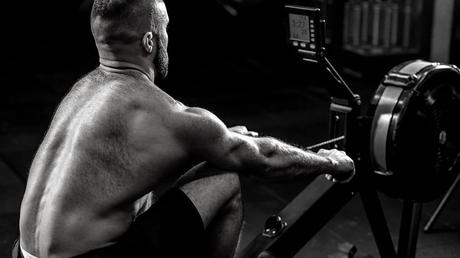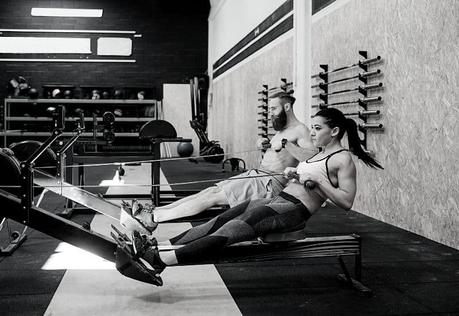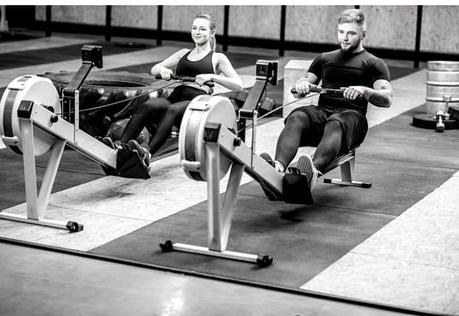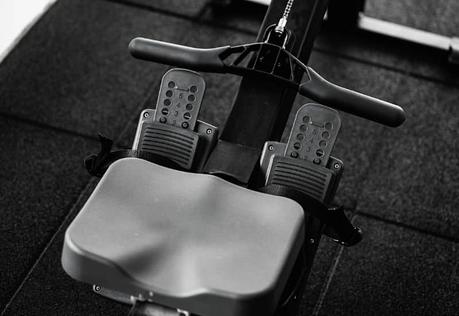The rowing machine is a monster for burning fat and building muscle. Here’s a look at all the muscles worked on the rower, tips for changing it up, and more.

- The Rowing Machine – Why You Should Use It
- Rowing Machines – Muscles Worked
- How to Work Different Muscle Groups on the Rowing Machine
- The Bottom Line
The rowing machine is a truly epic cardio machine, one of my all-time favorites for a functional workout!
Not only does it move your body through a “natural” range of motion mimicking rowing a boat, but the rowing machine works your upper back, shoulders, biceps, forearms, core, quads, and calves.
In this article, we’ll take a much closer look at all the muscles worked on the rowing machine, what benefits the rowing machine can offer, and how to make the most of the time you spend training with this machine.
By the end of this post, you’ll be ready to take your rowing machine workouts to the next level.
Let’s jump right in.
The Rowing Machine – Why You Should Use It
What makes the rowing machine such a great choice for your weekly workouts?
You’ll be surprised by how many benefits of the rowing machine:
 Full Body Training
Full Body Training

As you’ll see in the section below, the rowing machine works pretty much your entire body (all except your “push” muscles).
What this means is that rather than focusing primarily on your lower body like most cardio machines (stair climber, treadmill, stationary bike, elliptical machine, etc.) do, the rowing machine will work your entire body at the same time.
The more muscles you engage, the more calories you burn, and the more energy you expend. The low-intensity nature of rowing means you’re working out in an “aerobic state” where your body can absorb enough oxygen to burn fat for energy.
The result: better weight loss!

 Excellent Long-Term Fitness Results
Excellent Long-Term Fitness Results

The rowing machine is easily one of the best cardio machines for losing weight thanks to the fact that it works so many muscles.
As explained above, more muscle engagement means you’re burning through your stored energy supply more quickly, which means your body has to activated stored fats to use as energy.
Over time (weeks and months of regular training), this increased fat-burning will lead to long term weight loss—but not just weight, but actual fat being burned away through your exercise.
 Low-Impact Exercise
Low-Impact Exercise

When you run (on a treadmill or outside), there is an impact every time you place your foot down. This impact isn’t significant if you just run a few miles a week.
However, for people who run longer distances more frequently, the impact can accumulate, causing enough damage or wear and tear on your joints that you’ll start to experience aches and pains, even joint problems over time.
Low-impact exercise, on the other hand, involves little to no impact on your joints. You can still burn a lot of calories, but without damaging your joints or bones. Even with repeated exercise, there is minimal risk of long-term skeletal problems, which makes it “safer” for you to sustain for years at a time.
Rowing is an amazing low-impact exercise. You’re sitting down the entire time, which means there is no transfer of weight onto your feet (which is what happens when you walk, run, or jog).
You’re simply sliding forward and backward on the seat, using your muscles to go through the rowing motion, but with minimal risk of damaging your joints.
This makes rowing one of the safest forms of cardio you can do, and it’s very sustainable in the long-term.
 Joint-Friendly Training
Joint-Friendly Training

This goes hand-in-hand with the last benefit! Rowing isn’t just going to reduce the impact to your joints; it can actually increase your mobility and help your joints to move more smoothly through a much fuller range of motion.
When you start rowing, it’s likely that you’ll feel a bit of discomfort at the “extremes” of the rowing motion—such as when your knees are bent or when your elbows are pulling in close to your side.
Initially, your joints may not have as much mobility as you’d like, so there is stiffness and inflexibility. Over time, however, your body will grow accustomed to the range of motion, and your joints will stretch and grow more elastic during those motion “extremes.”

You’ll be able to bend your knees just a little more every day, and your arms will flow through that pulling range of motion more efficiently.
Multi-joint movements like rowing are amazing for improving your mobility, and will do wonders to keep you limber and flexible well into your later years, combatting the natural decrease in movement that comes as a result of aging.
 Functional Training
Functional Training

With some forms of exercise, you’re just training to train and burn calories. The movements won’t necessarily translate into more efficient activity in your daily life, but that’s okay because of all the benefits listed above.
However, “functional” exercise refers to any exercise that makes you more efficient at the “normal” activities you’d get up to every day: running, cycling, paddling, snowboarding, skiing, playing with your kids, cleaning your house, and the list goes on.
Rowing is a wonderfully functional exercise! Anyone who’s spent their summer months paddling a canoe, kayak, or paddleboard or rowing a boat will know exactly how demanding it can be on your body. Spending time on the rowing machine will strengthen the exact muscles you’ll use to paddle or row your watercraft.
That way, when the time comes that you actually get out on the water, you’ll have greater strength and endurance to row. It translates into more effective rowing in real-life situations, not just perceived “fitness gains” in the gym.
The rowing machine is an excellent cardio machine that is easy on the joints, burns a metric ton of calories, is highly functional, and works just about every major muscle group.
Rowing Machines – Muscles Worked
As the title of this post promises, we’re going to take a deep dive into the muscles worked on the rowing machine.
The reason I love the rowing machine more than most other cardio machines in the gym is that (as you saw above) it delivers a full-body workout. Essentially, it engages most of the muscles in your body, delivering a far more effective training session overall, not to mention burning more calories.
Most cardio machines focus a lot on the lower body, and the rowing machine is no exception. The American Fitness Professionals Association1 estimates that in your average rowing stroke, your lower body does anywhere from 65 to 75% of the work.
That’s A LOT!
It all comes down to the way you move through the stroke. There are basically four stages in the rowing stroke:
Stage 1: The Catch. During this stage, you’re leaning forward, with your hands stretched out in front of you, arms at full extension, holding onto the handle and getting ready to pull back.
Stage 2: The Drive. Even while you’re still leaning forward, your legs begin to push, propelling you backward. As you slide backward, you hinge at the torso and lean back.
Stage 3: The Finish. In this stage, you’re tilting backward until your upper body is just slightly past vertical (at an “11 o’clock” position), and that’s when your arms engage to pull the handle toward you. Ideally, you want to pull it directly toward your abdomen, aiming for the base of your sternum.
Stage 4: The Recovery. Once you finish the stroke, you lean forward and bend your legs to pull your body forward to set up for the Catch once more.
Most of the work of your stroke is done during Stage 2, the Drive.
Your legs do the majority of the work of pushing you backward.
This places a lot of emphasis on your:
- Quads
- Glutes
- Calves
During the Catch, you begin to brace your core muscles in order to begin pushing backward in the Drive. Throughout the Drive and Finish, your core muscles remain engaged to maintain a strong upper body.
This places emphasis on:
- Abs
- Lower back
Of course, don’t forget about your upper body!
All that work you’re doing of pulling on the handle to “row the boat” will lead to excellent muscle-building in your “pull muscles”:
- Upper back
- Shoulders
- Biceps
- Forearms
There are a few muscles that don’t get a ton of use (such as your obliques, hamstrings, and “push muscles”), but the majority of your muscles are engaged and working hard during the rowing movement.
That’s what helps you to burn so many calories and makes the rowing machine such a challenging workout.
The rowing machine is one of the very few cardio machines in the gym that target the upper body muscles as well as the lower body.
How to Work Different Muscle Groups on the Rowing Machine
You’re going to be a bit disappointed when you learn that the rowing machine isn’t the best for targeting different muscle groups.
Some machines—such as the elliptical—are incredibly versatile and can be used to effectively target multiple muscle groups in many different ways. With the rowing machine, though, you’re really only targeting the same muscles (those we listed above) in the same way.
That being said, there are a few slight variations that can adapt the way the rowing machine engages your muscles.
Reverse Your Grip
Reversing your grip on the rowing machine handle will change the way it engages your pull muscles—similar to the way switching from a standard overhand pull-up grip to a reverse chin-up grip does.
Your standard overhand grip targets the upper back more effectively, but reversing your grip (so you’re gripping the rowing machine handle from underneath, with your palm facing up) will increase the amount of work your biceps do when pulling on the handle.
You will find that this will limit your range of motion—you won’t be able to pull it as close to your body as with an overhand grip, because your wrists can’t flex quite as much in the underhand grip—and it could increase wrist strain.
However, if you spent 5-10 minutes during your 30 to 60-minute rowing session rowing with this underhand grip, it could help to target your biceps more effectively without increasing the risk of joint strain.
Row One-Handed
This is a fun twist on the rowing movement—and I do mean that literally!
Think about one-handed cable rows: when you pull the cable handle toward your body and twist your torso so you can pull as far back as possible, a LOT of muscles are engaged at the same time.
Your back, shoulder, and biceps are doing most of the work, but your abs, lower back, and obliques also get involved to facilitate that twisting movement of your torso.

Rowing machines are not usually designed for one-handed rowing, so you’ll have to find some way to grip the handle that facilitates the movement.
(I typically grip it so the chain/carabiner/cable clip point is placed directly between my middle and ring finger for a more balanced grip.)
You shouldn’t row one-handed for too long—it will diminish the effectiveness of the workout overall and burn fewer calories—but it’s a great way to target your muscles one side at a time during a long rowing session.
Row One-Legged
This is a fun variation to try for a few minutes at a time!
Remember how your legs end up doing the majority of the work during your rowing motion? What if it was just one leg doing all that work? Talk about results.
You shouldn’t remove your feet from the pedals, but try to focus on using just one leg to do all the work of driving you backward and pulling you forward. Spend 60 seconds of rowing with each leg to see how it feels.
It’s definitely not an easy movement to adapt to. Your body is accustomed to working with both legs at the same time, so it may feel awkward at first. Like rowing one-handed, it’s a fun variation to incorporate into your training session, but shouldn’t make up the bulk of your rowing time.
Although the movement on the rowing machine doesn’t leave a lot of room for variations, there are some ways to spice things up to target different muscles.
The Bottom Line
The rowing machine is one of the most effective machines in the gym for a fat-burning, stamina-increasing workout.
Not only does it work out most of your muscles, but it’s a low-impact form of exercise that is safe to sustain for years at a time.
It’s an amazing way to get fit doing an exercise that will translate into more functional fitness in a practical way—your summer months will be so much more enjoyable when you’re out rowing and paddling smoothly on the water thanks to the time you spent training on the rowing machine.
More Rowing Machine Guides and Articles
The Different Types of Rowing Machines (Pros and Cons of Each). Wondering what type of rowing machine is right for you? From low impact to high intensity, here’s a look at the different types of rowing machines.
